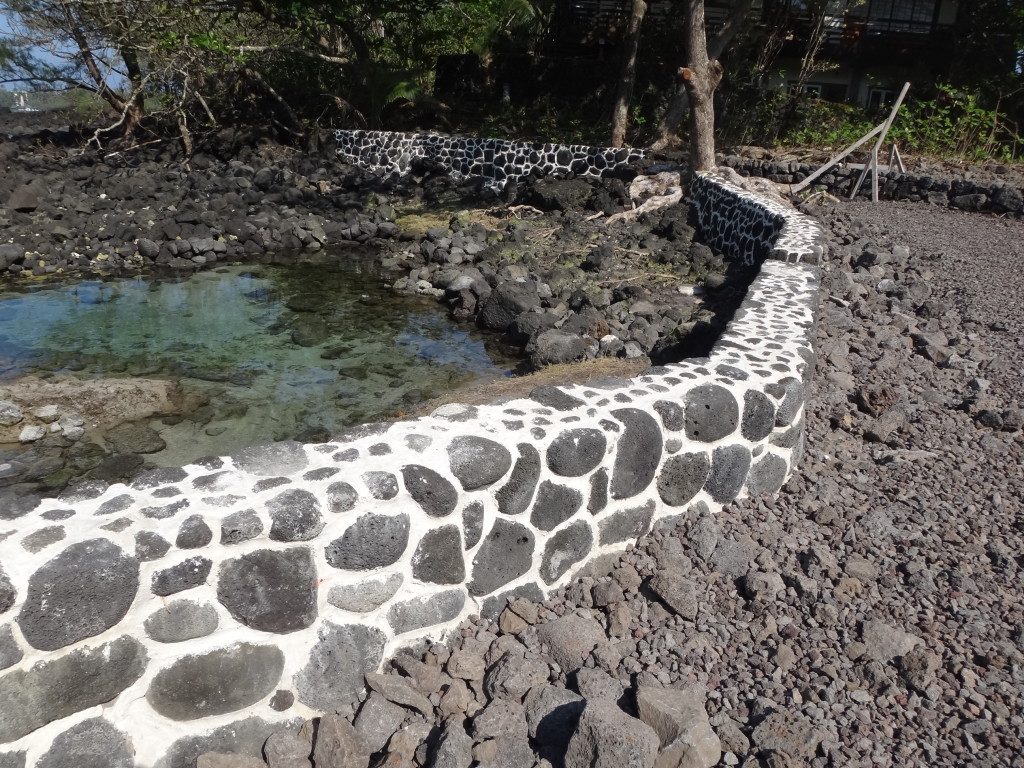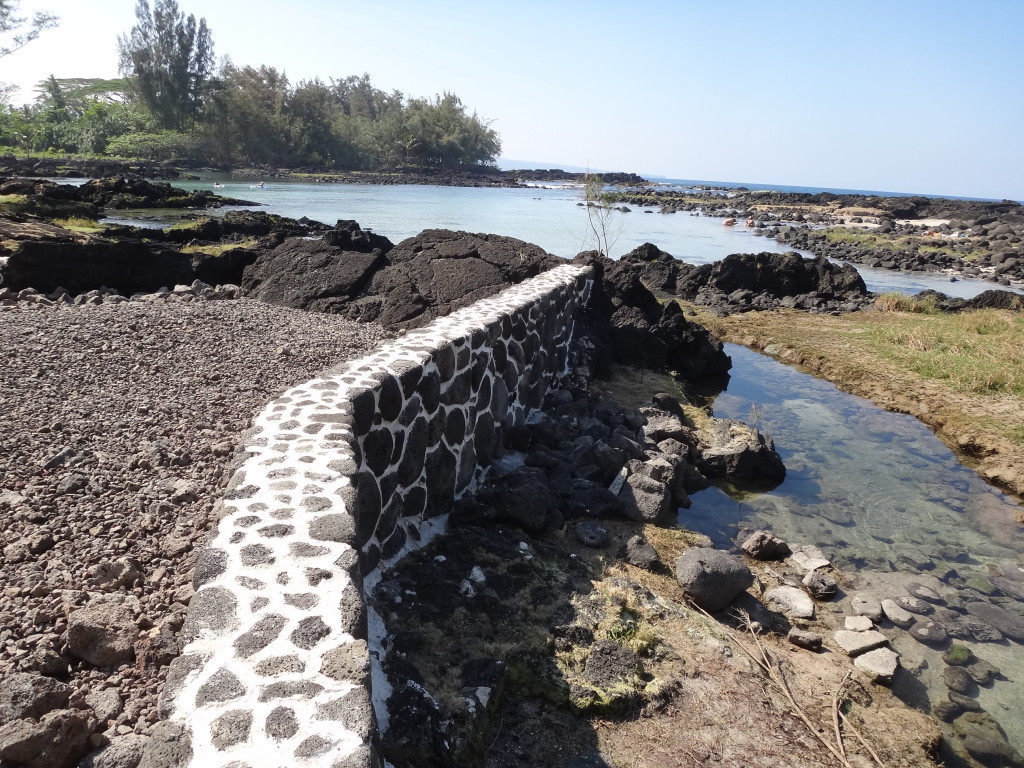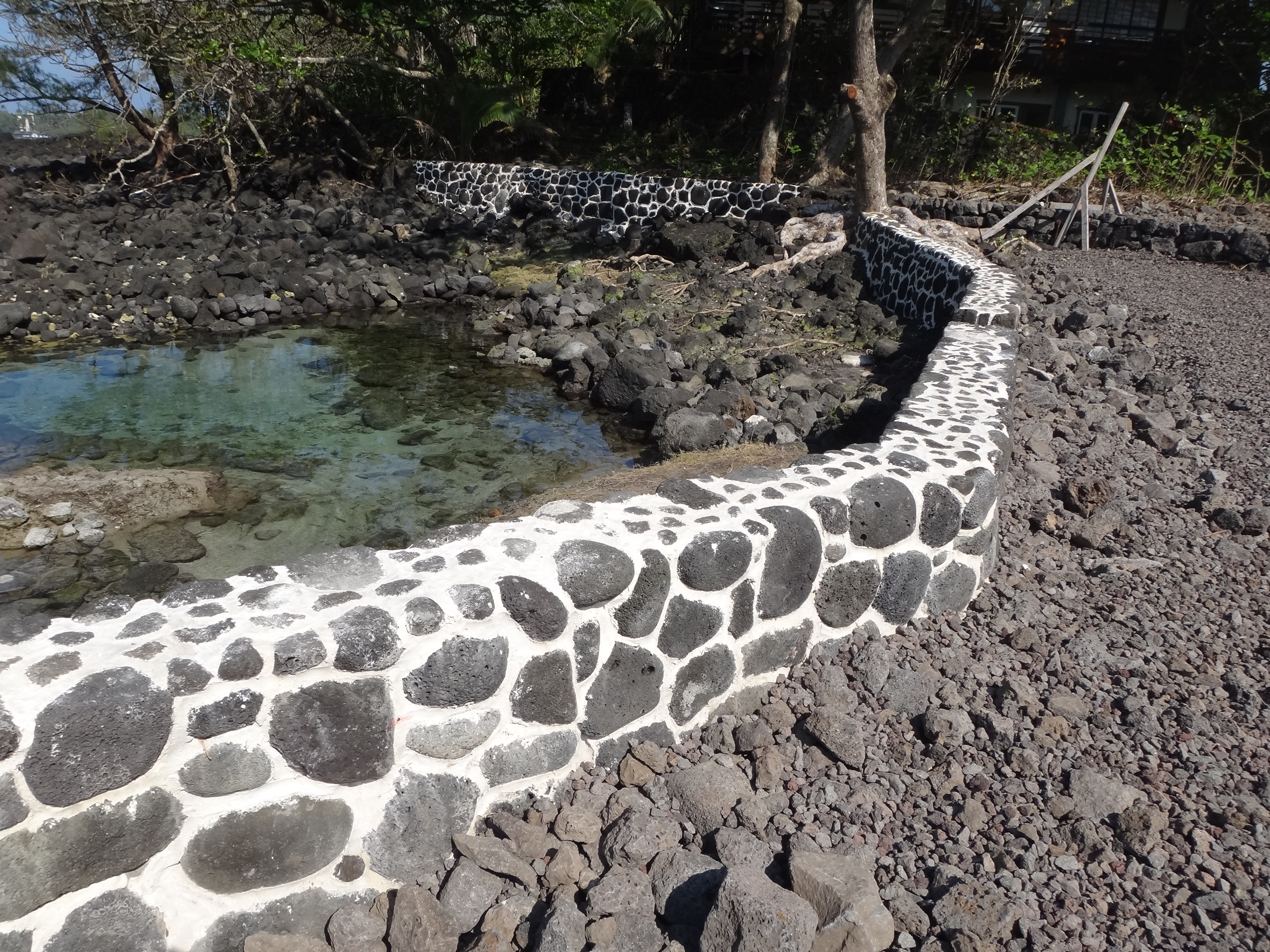
 There’s a brand new seawall in the Keaukaha district of Hilo. State and county laws establish stringent conditions before permits for this type of construction can begin, but the builder in this case, Honolulu architect Robert K. Iopa, didn’t bother with any of them.
There’s a brand new seawall in the Keaukaha district of Hilo. State and county laws establish stringent conditions before permits for this type of construction can begin, but the builder in this case, Honolulu architect Robert K. Iopa, didn’t bother with any of them.
Instead, he and Clayton Honma, head of the Hawai`i County Department of Parks and Recreation, appear to have conspired to allow the wall to be built under a “Friends of the Park” agreement, which itself was worked out without following the department’s own rules.
The new wall, in an area locals call Lalakea ice ponds, generally follows the alignment of a much older wall that was destroyed in the 1946 tsunami, if not earlier. On the mauka side lies a 17,800-square-foot lot purchased by Iopa in 2012. This is where Iopa intends to build a house that he says was inspired by a tale of a giant crab, `A`ama Nui, that watches over the area. The tale itself was written by Iopa and kumu hula Pualani Kanahele and was published by his architectural firm, WCIT Architecture, as a children’s story book, `A`ama Nui: Guardian Warrior Chief of Lalakea.
That book, which Iopa describes as the first installment in a planned “Hawaiian Architectural Book Series for Children,” reveals the design that he has drawn up for not just the house but the grounds as well. There is a 2,630-square-foot living area on the second floor, elevated about 20 feet above the ground. The paved lower level serves as a patio and carport. The upper-level decks and a high observation post that rises above the roof look out over the rocky coastline, which is part of a long strip of land that the was given over to the county’s management as a park back in 1927 by territorial governor Wallace R. Farrington. (At the time of Farrington’s executive order, the area of the park land was said to be 39 acres; today, the area is estimated to be around 17.4 acres.)
In the book’s description of the garden, a water feature – a circular “plunge pool or hot tub” – is to be located immediately behind the “restored historic rock wall.” “Mother of pearl” tile would line the pool floor, representing the giant crab’s one eye.
Documents obtained from the county suggest Iopa has abandoned plans for the pool. In all other respects, he has reshaped the area to accord with his vision.
A ‘Friend of the Park’
Documents released to Environment Hawai`i suggest Iopa first floated his plans to the county sometime last year. An email he sent to county parks director Clayton Honma on November 2 (and copied to planning director Duane Kanuha and deputy corporation counsel William Brilhante) states that he was writing “in regard to my property in Keaukaha that we discussed a few months back.”
“I am interested in moving forward with the ‘Friends of the Park’ agreement with the county (P&R [Parks and Recreation]) as discussed and wanted to see how best to complete this process.”
Iopa suggested there was a need to act quickly on his request. “[I]t is of interest to mention that I have talked to [wall builder] Billy Fields and he is available to do the restoration/repair and new work. Billy has his crew in Hilo for the next month working at the Hilo Police Station. My best timing to begin my work would be right after he is done at the police station. Regardless of timing, I am very interested in having Billy do this work. As a master mason, I would have to believe that the added significance of his craftsmanship to the public wall section would be of great interest to the county for future posterity. … Of course, I would have a personal interest too.” (The ellipsis appears in the original.)
Honma responded encouragingly just a day later. “[A]fter our review and approvals, you can proceed with your project,” he told Iopa. “Whatever permits required are expected to be done by you, however, if you need any EA [environmental assessment] exemptions from us for our portions, we can have that written up.”
The Parks Department’s Rule 12 sets out the conditions for such agreements, stating that they are open to “all community groups and organizations.” On November 17, however, when Iopa submitted his FOP application, just he and his wife were listed as the applicants. Work to be done under the Friends agreement, he said, included: “repair existing rock wall …; remove 3-5 existing ironwood trees (invasive) and plant 2-3 new native trees (kou or milo).” The wall repair, he indicated, was optional “if problematic.” The “preferred option,” however, would include “loko i`a wall repair.” (The description of the structure as a fishpond, or loko i`a, wall is novel. Although there are fishponds in the area, there is no known fishpond that this wall would have been a part of.)
Honma signed the agreement on November 19 and returned it to Iopa on December 4. The agreement, he said, “includes repairing the existing loko i`a rockwalls which are located adjacent to your property.”
Meanwhile, at Planning
Just one day after Honma had signed the Friends of the Park agreement, Iopa applied to the Planning Department for a Special Management Area (SMA) permit, submitting his application on the “short form assessment for non-shoreline parcels.” The permit would allow him to build his house and associated improvements. The department rejected this, apparently finding that his property did not qualify as a “non-shoreline parcel.”
On December 21, Iopa applied again, this time filling out the county’s SMA “use permit assessment application,” with the help of planner William Moore. The application was for his house and related improvements, including a driveway, landscaping, and a dry-stack wall within the shoreline setback area. “In addition, the applicant is proposing to repair the existing stone walls along the makai boundary,” the application stated.
Although under state law, certified shorelines are valid for no more than one year, Iopa relied on a shoreline survey done in 1993 in stating that the residence would be “sited to assure it will be outside of the forty (40) foot shoreline setback area.” “Minor improvements and activities are proposed to be development [sic] within the shoreline setback areas,” he said, but these “will be limited to the construction of dry stack walls and landscaping that will not alter the existing grade of the shoreline setback area.”
On January 25, Planning Department director Kanuha notified Iopa that the department had determined that the “subject parcel is located entirely within the Special Management Area (SMA) and has frontage along the shoreline.” Because the proposed house was less than 7,500 hundred square feet of floor area and would not be part of a larger development, it “may be determined exempt from the definition of development,” Kanuha wrote. Therefore, the “proposed repairs and improvements … shall not require further review against the SMA guidelines.”
Although Iopa had stated he would be making improvements within the mandatory minimum 40-foot setback area (as measured from the 1993 survey), Kanuha granted him an exemption from the requirement that he would need to obtain a new certified shoreline survey that would define more precisely the boundaries of the setback area. Citing the department’s Rules of Practice and Procedure, he noted that “minor structures” were allowed so long as they did not “alter the existing grade of the shoreline setback area” and are limited to “landscape features (i.e., benches, chairs, borders, wooden trellis, bird feeders…); walkways for access; and sprinkler systems.” Landscaping and “minor clearing (grubbing) of vegetation” is also allowed, so long as the Planning Department determines that it would not affect beach processes or artificially fix the shoreline and would not interfere with public access or public views to and along the shoreline.
While Iopa got a pass on the dry stack wall, Kanuha specifically did not allow the rebuilding of the remnant stone wall. This, he said, “would require the submittal of a shoreline survey and additional information. Therefore the repairs to the existing stone walls are not being considered at this time.” (The emphasis is Kanuha’s.)
Back at Parks
Kanuha’s denial of permission to work on the rock wall did not stop Iopa from moving forward with his plan to rebuild it. Although the Parks Department has no legal authority to permit work in the SMA or on Conservation District lands, Honma did not instruct Iopa to work with either the Planning Department or the state Department of Land and Natural Resources’ Office of Conservation and Coastal Lands. In an article in the Hawai`i Tribune-Herald of April 17, Honma was reported to have claimed that the 1927 executive order executed gave his department jurisdiction over development in the area. (Honma did not respond to multiple requests for an interview from Environment Hawai`i.)
Six days after Kanuha’s denial of permission to rebuild the wall, Iopa obtained the required certificate of liability insurance from Big Island Tree Service, the company he had retained to remove ironwood trees straddling the area of the wall. Work began soon thereafter.
On February 19, a Friday, Iopa emailed the Parks Department, attaching the arborist’s certificate of insurance and mentioning his expanded plans for tree removal. “Additionally,” he wrote, “after further review of the onsite conditions, I would like to include two additional ironwood trees to our agreement for removal.” Honma apparently called Iopa to discuss the matter, and in an email dated Sunday, the 21st, Iopa thanked Honma for that. He also attached photos to his email, showing “the ironwood tree proposed for and/or recently removed per our Friends of the Park Agreement.”
Grainy copies of the photos provided to Environment Hawai`i show six large ironwood trees in and around the remnant stone wall. All have been removed.
No sooner were the trees taken down than workers moved in with backhoes and other equipment. The dry stack wall was built and work began on the mortared seawall. Within a few days, neighbors say, a high storm surge carried water up and over the dry stack wall, which was then rebuilt.
Although none of the work authorized by the Planning Department was supposed to alter the existing grade of the shoreline area, several cubic yards of fill were brought in and placed behind the new wall, making what was once a rocky area of tide pools now a level expanse. In addition, the wall-building, tree-cutting, and fill appears to have extended onto the property of Iopa’s neighbors and county park land.
Community Concerns
On March 14, the online news site BigIslandNow.com published a letter to the editor from Ardena Saarinen, asking members of the public to attend a meeting of the Leleiwi Community Association to be held that evening to discuss what she called an illegal wall.
Saarinen told Environment Hawai`i that the meeting was a disaster, with Iopa and his family members and friends attacking critics verbally.
Still, the rancorous meeting had one positive outcome. Bethany Morrison, a planner with the county, says that staff from the Planning Department visited the site on March 15 in response to complaints about work being done on Iopa’s property. Following that, Kanuha informally told Iopa to stop further work.
Since that time, no work appears to have been done – but then again, most of the work on the wall had already been finished at the time Iopa was told to stop work on the site.
In light of the community’s concerns, Iopa approached the Parks Department with a request to revise the Friends of the Park agreement. On March 29, he emailed Honma again, addressing him now as “Director Honma” instead of the more informal “Clayton” used in previous emails.
This time, Iopa said, he wanted to “amend the Friends of the Park Agreement I was granted. … As there has become greater attention regarding the work I had proposed as part of our original agreement, I think there is reason to further define and describe the proposed work to illustrate the extent and its intended public benefits.
“Assuming your acceptance of this amendment, I would look to proceed with a SMA application for the work contemplated.”
The attached letter bore a heading “Malama Kipuka Hawai`i,” although no address, phone number, or other contact information was provided either in the letterhead or in the letter itself. In it, Iopa stated that the organization was a 501(c)(3) organization, “where I presently service as the Board Chair.” The revised Friends of the Park agreement, Iopa proposed, would allow improvements and maintenance on approximately 1,600 square feet of land, half of which, Iopa claimed, was county park land and the remainder belonged to him and his wife.
“The Malama Kipuka Hawai`i proposal is to restore a part of the history of this place and to create an attractive and meaningful park setting for the communities [sic] use and enjoyment,” the letter continued. Five “proposed” improvements were listed: the wall restoration; removal of “invasive” tree species; “planting of native species tree and groundcover;” “maintenance of improved park area;” and “expanded park usage area.”
By this time, of course, the trees had already been removed and the wall built. It is not apparent from anything in the letter that Malama Kipuka Hawai`i had the authority to grant the public the use of the Iopas’ land.
(Whether Malama Kipuka Hawai`i is a 501(c)(3) organization, recognized by the Internal Revenue Service, could not be determined by Environment Hawai`i. The group did file articles of incorporation with the state Department of Commerce and Consumer Affairs last December 10, stating it was a non-profit corporation that would have no members. Signing as incorporator was Annie Okazaki, an attorney with the Honolulu firm of Alston Hunt Floyd & Ing. Iopa was listed as the organization’s agent.)
Two weeks after Iopa’s request to Honma, and a month after the Planning Department’s site visit, planning director Kanuha finally communicated formally with Iopa, instructing him to stop work “makai of the proposed dry stack rock wall.” He also notified Iopa that his office was undertaking an investigation into Iopa’s activities – not only on Iopa’s own property, but also on neighboring land as well as the park land. This, Kanuha said, was being coordinated with the Department of Parks and Recreation as well as the state Department of Land and Natural Resources, since “some of the work may have occurred seaward (makai) of the shoreline.”
Finally, Kanuha wrote, “We also require that you submit a shoreline survey for the above referenced property, as soon as possible, by securing a licensed surveyor, licensed by the State of Hawai`i. This survey will be used to determine the landowner authorization and jurisdiction needed for the work.”
If Iopa is found to have violated DLNR rules, he could face fines of up to $15,000 for each violation plus administrative costs, costs associated with land or habitat restoration, and damages to public land. If violations are found to be willful, the potential penalties could be much higher.
(Environment Hawai`i made repeated requests to Iopa and Honma for comment. Neither had responded by press time.)
— Patricia Tummons
Volume 26, Number 11 May 2016


Leave a Reply